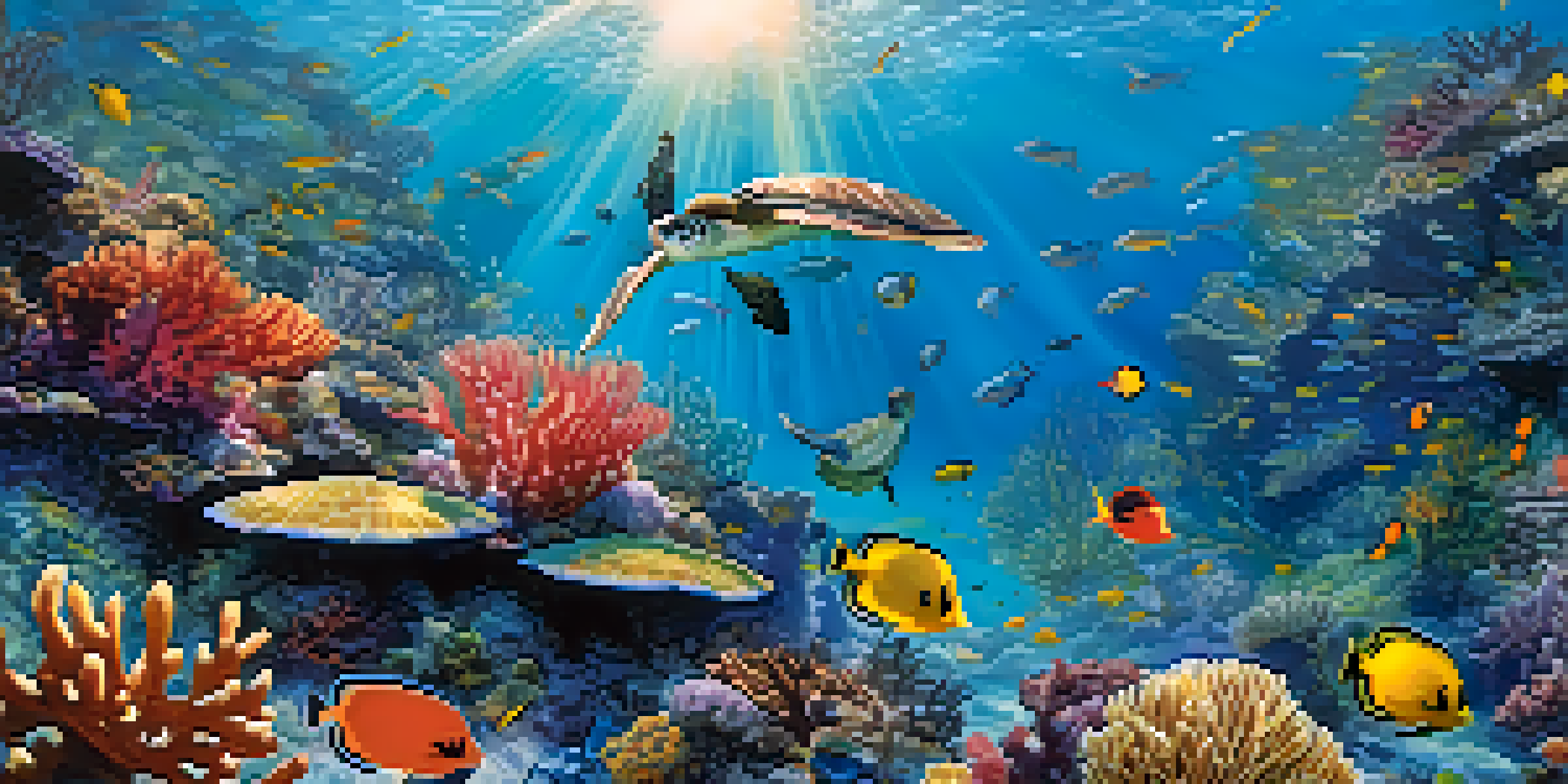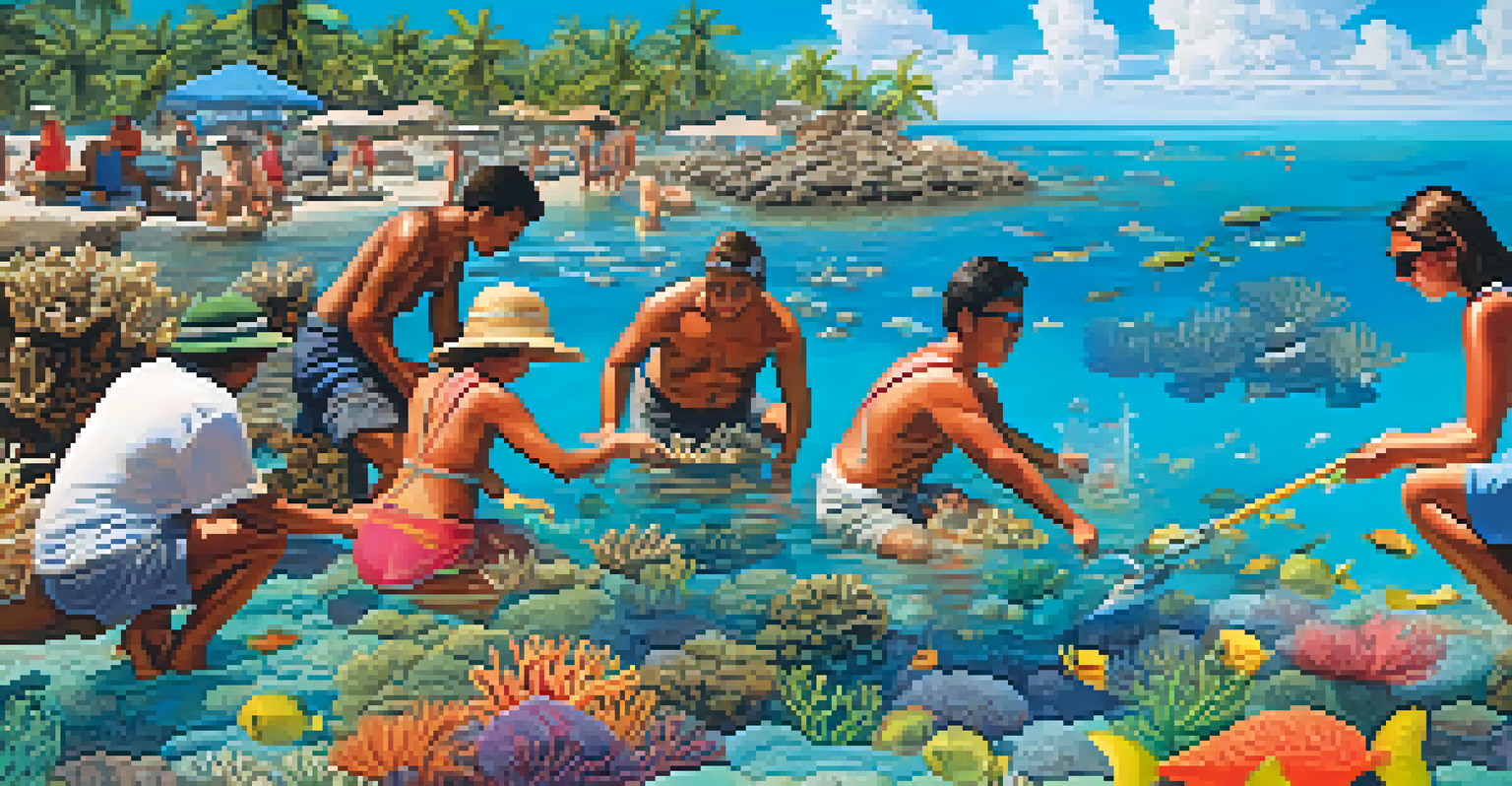Impact of Climate Change on Honolulu's Ocean Ecosystem Health

Understanding Climate Change and Its Effects
Climate change refers to long-term shifts in temperatures and weather patterns, often attributed to human activities like fossil fuel combustion. In the context of Honolulu, these changes are not just abstract concepts; they manifest in rising sea levels and increased ocean temperatures. This means that the delicate balance of marine life is increasingly at risk, affecting everything from coral reefs to fish populations.
We won't have a society if we destroy the environment.
As temperatures rise, oceanic heatwaves become more frequent, leading to coral bleaching events. This phenomenon occurs when corals expel the algae that give them color and nutrients, weakening their structure and health. The loss of coral reefs is particularly concerning as they provide habitat for many marine species, supporting biodiversity and local fisheries.
Additionally, climate change influences weather patterns, leading to more intense storms and altered rainfall dynamics. This can result in runoff that carries pollutants into the ocean, further stressing marine ecosystems. In Honolulu, understanding these connections is crucial for developing effective conservation strategies.
Rising Sea Levels and Coastal Ecosystems
One of the most visible impacts of climate change is the rise in sea levels, which poses significant threats to coastal ecosystems in Honolulu. As glaciers and polar ice sheets melt, more water enters the ocean, leading to coastal erosion and habitat loss. Mangroves and wetlands, which act as natural buffers against storms, are particularly vulnerable to these changes.

The loss of coastal habitats can have a cascading effect on marine life, disrupting breeding grounds for fish and other species. For example, juvenile fish often rely on mangroves for shelter and food; without these habitats, their chances of survival diminish. This not only impacts the species themselves but also the local fishermen who depend on healthy fish populations.
Climate Change Threatens Marine Life
Rising temperatures and ocean acidification are endangering vital marine ecosystems in Honolulu.
Moreover, the encroachment of saltwater into freshwater systems can affect the delicate balance of ecosystems. As saltwater intrudes, it can alter nutrient dynamics and harm freshwater species, leading to decreased biodiversity. Protecting coastal ecosystems is essential for maintaining the health of Honolulu's marine environment.
Ocean Acidification: A Hidden Threat
Ocean acidification is often overshadowed by more visible effects of climate change, but it poses a significant risk to marine ecosystems. As the ocean absorbs excess carbon dioxide from the atmosphere, it becomes more acidic, impacting organisms that rely on calcium carbonate, like corals and shellfish. This can weaken coral structures and hinder the growth of vital marine species.
The Earth does not belong to us: we belong to the Earth.
In Honolulu, the decline of coral reefs due to acidification can have dire consequences for the entire ecosystem. Healthy reefs provide shelter and food for countless marine creatures, and their degradation can lead to a decline in fish populations. This, in turn, affects local fisheries and the economy, as many families rely on fishing as a source of income.
Furthermore, ocean acidification can disrupt the food chain, impacting larger marine animals that rely on smaller species for food. As these foundational species decline, the entire ecosystem becomes less resilient, making it more susceptible to other stressors like pollution and overfishing. Addressing ocean acidification is crucial for the long-term health of Honolulu's waters.
Impact on Marine Biodiversity
The combined effects of climate change, rising sea levels, and ocean acidification are leading to significant changes in marine biodiversity around Honolulu. Many species are struggling to adapt to the rapidly changing environment, resulting in shifts in population dynamics and distributions. Some native species may decline, while invasive species could thrive, further complicating conservation efforts.
For example, warming waters can lead to a shift in fish species, with some migrating to cooler areas. This can disrupt local fishing practices and traditional cultural practices tied to specific fish species. The loss of biodiversity not only affects marine life but also impacts the overall resilience of the ecosystem, making it more vulnerable to further changes.
Rising Sea Levels Impact Fisheries
Coastal erosion and habitat loss due to rising sea levels threaten fish populations and local fishing livelihoods.
Additionally, the decline of biodiversity can reduce the ecosystem services that healthy oceans provide, such as carbon sequestration, nutrient cycling, and tourism opportunities. Protecting marine biodiversity is essential for maintaining the ecological balance and ensuring the sustainability of resources for future generations in Honolulu.
Effects on Local Fisheries and Economy
The health of Honolulu's ocean ecosystem is intrinsically linked to the local fishing industry, which plays a vital role in the economy and community culture. As marine habitats degrade due to climate change, fish populations may dwindle, leading to reduced catches for local fishermen. This not only threatens their livelihoods but also impacts food security for residents who rely on seafood as a primary protein source.
Moreover, changes in fish distribution can affect traditional fishing practices. Fishermen may find it increasingly challenging to locate their usual catches, forcing them to adapt or face economic hardship. This shift can lead to increased competition for dwindling resources, creating tension within the community.
In addition to direct impacts on fisheries, the decline in ocean health can affect related industries, such as tourism. Hawaii is renowned for its beautiful beaches and vibrant marine life, attracting countless visitors each year. If climate change continues to harm ocean ecosystems, it could deter tourists and negatively impact the economy, making conservation efforts even more crucial.
Community Responses and Adaptation Strategies
In response to the challenges posed by climate change, local communities in Honolulu are taking proactive measures to protect their ocean ecosystems. Initiatives such as coral restoration projects and marine protected areas aim to bolster the resilience of marine life. These efforts not only help preserve biodiversity but also foster community engagement in conservation activities.
Education plays a vital role in these initiatives, as local organizations work to raise awareness about the importance of healthy oceans. By involving residents in monitoring and conservation efforts, communities can create a sense of ownership and responsibility towards their marine environment. This grassroots approach can lead to more sustainable practices and better outcomes for local ecosystems.
Community Engagement for Conservation
Local initiatives and education are essential for fostering community involvement in protecting Honolulu's ocean ecosystem.
Additionally, collaboration between government agencies, non-profits, and local communities is essential for addressing the complex challenges of climate change. By sharing resources and knowledge, stakeholders can develop more effective strategies and adapt to the changing conditions. Together, these efforts can create a more resilient ocean ecosystem in Honolulu.
The Path Forward: Sustainable Practices
To safeguard the health of Honolulu's ocean ecosystem, adopting sustainable practices is crucial. This includes responsible fishing techniques, reducing plastic waste, and advocating for policies that protect marine habitats. By making conscious choices, both individuals and businesses can contribute to the health of the ocean.
One practical example is the promotion of sustainable seafood options, encouraging consumers to choose fish caught using environmentally friendly methods. This not only supports local fishermen but also helps preserve fish populations and habitats. By shifting consumer demand towards sustainability, we can create a market that values ecological health.

Ultimately, the path forward requires a collective effort from all sectors of society. By working together, we can implement strategies that protect the ocean ecosystem for future generations, ensuring that Honolulu remains a vibrant hub of marine life. It’s a shared responsibility that can lead to meaningful change and a healthier planet.